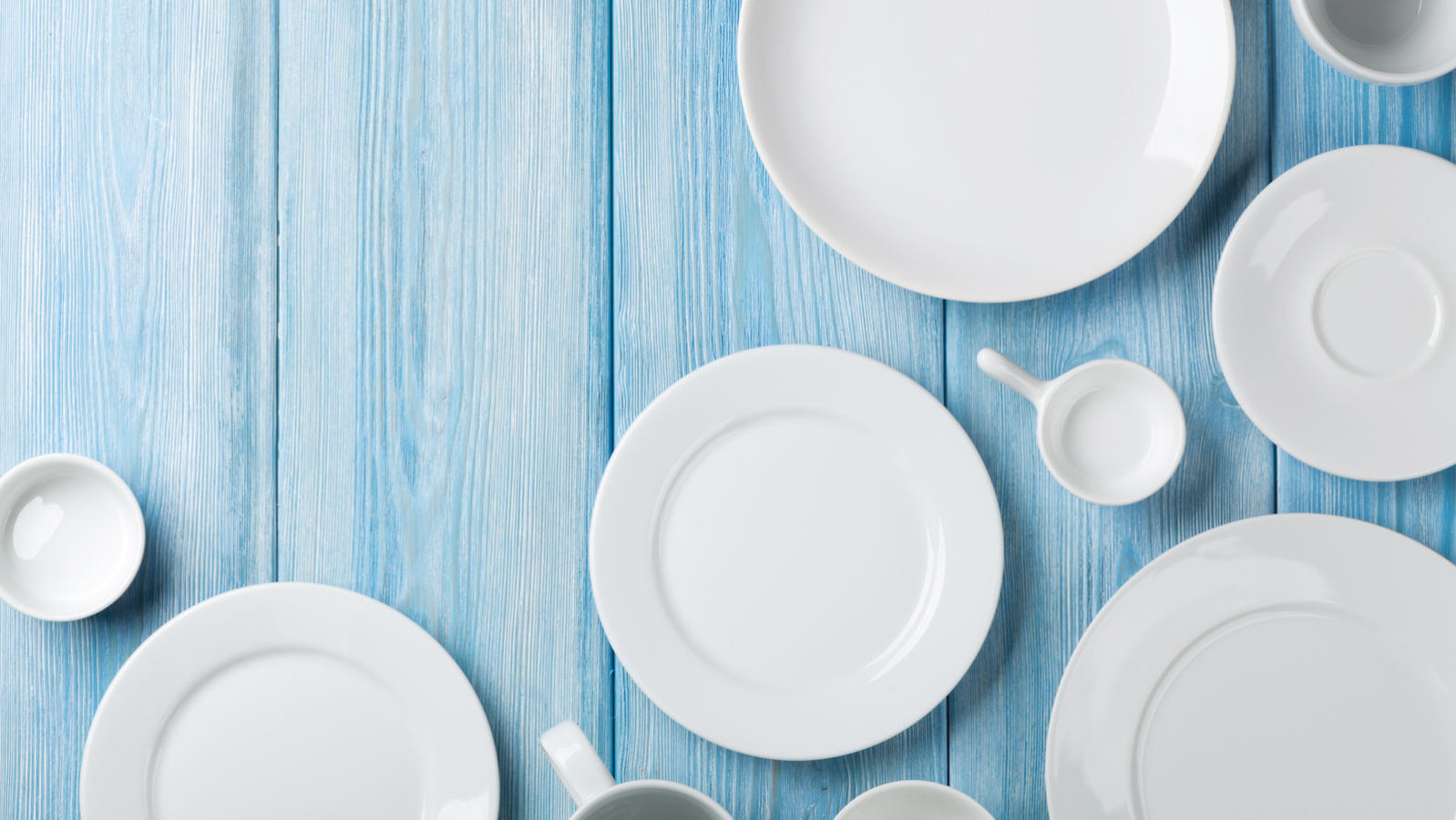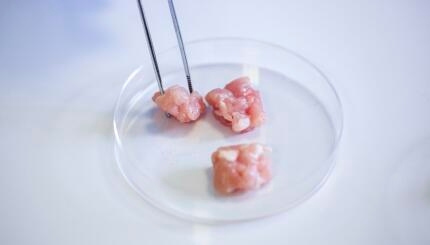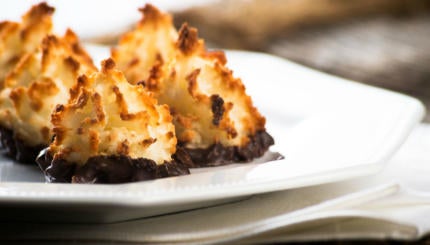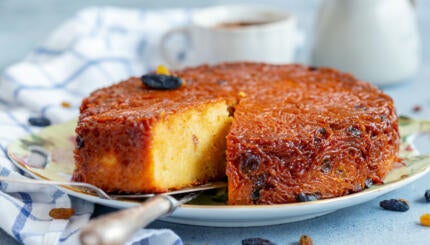Dishes can be made of several substances: china, earthenware, glass, wood, various plastics, metal. Some can be kashered [made kosher], some cannot, some are debatable.
Leviticus 6:21 says, “And the earthenware vessel in which it was cooked shall be broken; and if it was cooked in a brazen vessel, it shall be scoured, and rinsed in water.” This verse is the basis for certain rules of kashering dishes, and what may or may not be kasherable.
Whether or not you can keep the dishes you already own depends on the material from which they are made. If the dishes are “earthen,” that is, china or stoneware, it is most likely you will not be able to keep them, at least not for immediate use. Unglazed earthenware cannot be kashered at all, as the porous ceramic permanently absorbs juices and flavors from foods.
Chinaware
Nowadays, glazed chinaware can be relatively inexpensive, especially compared to 50 or 150 years ago. Consequently, Orthodox and Conservative opinions on keeping dishes that were previously used in unkosher kitchens have become stricter. The general opinion is, chinaware cannot be kashered.
With your help, My Jewish Learning can provide endless opportunities for learning, connection and discovery.
Thickly glazed china or fine china, family heirloom material, can sometimes be made kosher, but it must sit, unused, for at least 12 months; have a rabbi check your china to determine if this rule is applicable. This is the amount of time deemed necessary for dissipation of all unkosher flavors. If the glaze is thin and could easily flake off, the dish likely cannot be kashered. The alternative is to find a kiln and heat the ceramic items at kiln temperatures (about 2,000 degrees Fahrenheit), but at that heat the china might break.
The rule regarding chinaware applies not only to place settings, but to serving platters, as well as mixing bowls, fruit bowls, and so on. Items that are never used with hot food, such as a ceramic fruit bowl or a sugar bowl, are not treif [unkosher] and don’t need kashering.
Teapots, if they were never used with flavored tea, may not need to be kashered and can be kept; check with your rabbi.
Glass
Glass has been controversial, in both Conservative and Orthodox rulings, in terms of determining what material category it fails under. Glass is made of sand, so is it earthenware? Yet it does not absorb as earthenware does, so is it like metal? In the Shulchan Aruch, Joseph Caro writes that glass dishes “need no kashering since they do not absorb,” while Moshe Isserles writes, “And some are more stingent and say that even purging by boiling is of no effect in their case.” The ultimate Conservative and more common Orthodox conclusion is that glass is neutral, and can be kashered simply by washing.
However, because glass is neutral, the question has been raised: Could the same dishes be used for dairy and for meat, just washing them in between uses? While technically this is a possibility, both Conservative and Orthodox rules frown upon this as a practice. It is too easy for incidents of basar b’halav [meat and dairy mixing] to happen. Keeping track of when you used the dish last, if you washed it appropriately, and so on make it problematic to use the same glass dishes for hot dairy and meat foods.
Drinking glasses, however, since they are used only for cold substances, may be used with both dairy and meat meals. A mahmir [strict] Orthodox stand is to have separate drinking glasses for dairy and meat, but using one set of drinking glasses is not only acceptable but common practice.
Glass that is used for baking, such as Pyrex, is a separate issue. The Conservative ruling is that Pyrex and such materials are treated the same as other glassware, and can be kashered simply by washing. The Orthodox stand on Pyrex, on the other hand, is that it and other glassware that has been used for baking cannot be kashered, and must be replaced.
There are two ways to kasher glasses: by simply washing them and waiting 24 hours, or by milui v’irui [soaking]. This method, soaking, is primarily used to prepare glassware for Pesach, but it may also be used when going from an unkosher to a kosher kitchen. Place the glassware in a single layer (no stacking) in a large container (this may be done in a cleaned bathtub that hasn’t been used for 24 hours). Cover with water completely. The glassware needs to soak 72 hours, but you must change the water after 24 hours and again after 48 hours. At the end of the 72 hours, drain and wash the glassware.
Boiling
The kashering method used for most foodware is hag’alah [scouring or boiling]. It is used primarily for dishes and flatware made of metal, stone, wood, and rubber. According to Conservative halacha (Jewish law), it can also be used for hard plastic, such as Melmac (the brand name for melamine). Orthodox opinion on this issue varies. Some say plastics are kasherable, some say they are not. Since most plastics are not used in an oven or over a direct flame, there is a certain amount of leniency here.
Hag’alah means “boiling.” You need a very large pot for this, ideally one dedicated to the kashering process. When we kashered our kitchen when I was a kid, my mother purchased a huge pot, larger than any we’d ever used. Part of the koshering process calls for a large stone, and my mother asked for the permanent loan of a heavy, smooth stone I had found on the school playing fields some months before. The stone can serve two purposes. One, it helps maintain the heat of the boiling water as objects to be kashered are added. And two, it is used to kasher large pots, by dropping it into the pot in order to cause the water to overflow down the sides.
To do hag’alah for dishes, bring the water to a rolling boil. If the plate is platter-sized and is too big to be submerged completely, rotate it. Submerge half, and then rotate it and submerge the other half, holding each part in the water for about 30 seconds. Plates, even smaller ones, should be kashered one at a time. The water has to touch the entire surface of the plate, and if plates are overlapping, there might be part of one that would not be sufficiently kashered. According to Conservative ruling, this method may be used for plastic dishes; according to most Orthodox halakhah, it may not.
Cutting Boards
Cutting boards made of wood can be kashered through hag’alah, but they must first be sanded down and bleached, similar to the method used to kasher a wooden countertop. This can be tedious for a cutting board, and you may opt to purchase a new one. A plastic cutting board should be replaced.
Reprinted with permission from How to Keep Kosher (HarperCollins).
kasher
Pronounced: KAH-sher, Origin: Hebrew, to make kosher, usually referring to dishes, cookware or a kitchen.
kosher
Pronounced: KOH-sher, Origin: Hebrew, adhering to kashrut, the traditional Jewish dietary laws.
Moshe
Pronounced: moe-SHEH, Origin: Hebrew, Moses, whom God chooses to lead the Jews out of Egypt.



